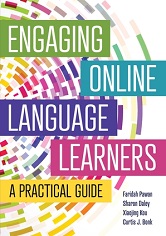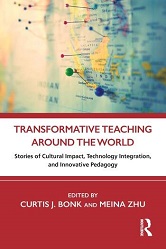|
About the Author
Bonk background: This is the bookshelf of Curtis
J. Bonk, Ph.D. 
Curtis J.
Bonk is Professor
in the School of Education at Indiana University (IU) teaching psychology and
technology courses and Adjunct in the School of Informatics at IU. He is a
former software entrepreneur, certified public accountant, corporate
controller, and educational psychologist who presently is an educational
technologist, award-winning writer, highly published researcher, statewide and
national awardee in innovative teaching with technology, and internationally
acclaimed presenter. In 2020, he was awarded the IU President’s Award for
Excellence in Teaching and Learning Technology – and in 2021, received the
David H. Jonassen Excellence in Research Award. In April 2022, the American
Educational Research Association named him a 2022 AERA Fellow for his
exceptional contributions to, and excellence in, education research and the
following week he was honored with the International Engagement award from the
IU School of Education. Curt is the author of nearly 400 publications and has
many widely used technology and learning related books, including Transformative
Teaching Around the World, Engaging Online Language Learners, The
World Is Open, Empowering Online Learning, The Handbook
of Blended Learning, Electronic Collaborators, Adding
Some TEC-VARIETY, which is free as an e-book (http://tec-variety.com/), and MOOCs and Open Education Around the
World as well as MOOCs and Open Education in the Global
South (www.moocsbook.com/). Across his career, Curt Bonk has
given over to 1,800 presentations around the globe related to online teaching
and learning, including over 300 keynote and plenary talks in places like
Bangkok, Thailand, Melbourne, Sydney, Shanghai, Hong Kong, Singapore, Beijing,
Toronto, Abu Dhabi, Riyadh, Madrid, London, Manila, Seoul, Tel Aviv, Edinburgh,
Dublin, Coimbra, Tampere, Barcelona, and Arequipa, Peru. He can be contacted
at cjbonk@indiana.edu and his homepage is http://curtbonk.com/.
|
Selected Books and Special Issues by Curtis J. Bonk
Pawan, F., Daley, S., Kou, X., & Bonk, C. J. (2022). Engaging Online
Language Learners: A Practical Guide. DC: TESOL.
While engaging and motivating students in the classroom has always been critical for student success, it is even more important and challenging in the online learning environment. This practical guide will provide English language educators with a number of strategies and ready-to-use activities to help them engage and motivate their students for improved learner outcomes. It also covers trends in online learning, engagement and motivation principles and competencies, as well as ways administrators can support teachers' professional development. As an additional resource, the book comes with a companion website. For more information visit TESOL or Amazon.
|
Bonk, C. J., & Zhu, M. (Eds.). (2022). Transformative Teaching Around the World: Stories of Cultural Impact, Technology Integration, and Innovative Pedagogy. NY: Routledge.
Transformative Teaching Around the World compiles inspiring stories from Fulbright-awarded teachers whose instructional practices have impacted schools and communities globally. Whether thriving or struggling in their classrooms, instructing in person or online, or pushing for changes at high or low costs and risk levels, teachers devote intense energy and careful decision-making to their students and fellow staff. This book showcases an expansive variety of educational practices fostered across international contexts by real teachers: active and empowering learning strategies, critical thinking and creative problem-solving, cultural responsiveness and sustainability, humanistic integration of technology, and more. Pre- and in-service teachers, teacher educators, online/blended instructors, and other stakeholders will find a wealth of grounded, motivating approaches for transforming the lives of learners and their communities. For more information visit Routledge or Amazon or http://openworldbooks.com/book.php.
|
 |
Zhang, K., Bonk, C. J., Reeves, T. C., & Reynolds, T. H. (Eds.). MOOCs and Open Education in the Global South: Challenges, Successes, Opportunities.
With e-learning technologies evolving and expanding at high rates, organizations and institutions around the world are integrating massive open online courses (MOOCs) and other open educational resources (OERs). MOOCs and Open Education in the Global South explores the initiatives that are leveraging these flexible systems to educate, train, and empower populations previously denied access to such opportunities.
Featuring contributors leading efforts in rapidly changing nations and regions, this wide-ranging collection grapples with accreditation, credentialing, quality standards, innovative assessment, learner motivation and attrition, and numerous other issues. The provocative narratives curated in this volume demonstrate how MOOCs and OER can be effectively designed and implemented in vastly different ways in particular settings, as detailed by experts from Asia, Latin America, the Middle East, Africa, the Pacific/Oceania, and the Caribbean.
This comprehensive text is an essential resource for policy makers, instructional designers, practitioners, administrators, and other MOOC and OER community stakeholders.
|
The MOOCs and Open Education special issue of the International Journal on E-Learning (IJEL) is now published! It was edited by Mimi Miyoung Lee, Curtis J. Bonk, Thomas H. Reynolds, and Thomas C. Reeves (2015).
In April of 2001, the president of MIT, Charles Vest, announced the establishment of a project for placing MIT course contents on the Web for free access by anyone with an Internet connection. In effect, this announcement started the OpenCourseWare (OCW) movement. Since that time, open educational resources (OER) and more recently massive open online courses (MOOCs) have proliferated. A flurry of research reports, books, programs, announcements, debates, and conferences related to MOOCs and open education have encouraged educators to reflect on how these new forms of educational delivery might enhance or even transform education. As part of this global movement, the four editors of this special issue, Mimi Lee, Curt Bonk, Tom Reynolds, and Tom Reeves, organized a one-day preconference symposium on this topic at the International E-Learn Conference in Las Vegas in October 2013. One direct result of that event is this special issue of the International Journal on E-Learning (IJEL), which contains highly informative and important papers related to the present and future of MOOCs and Open Education around the globe. For more information from the AACE EdITLib: editlib.org/j/IJEL/v/14/n/3/. See also MOOCs Book Home: MOOCsbook.com
|
|
Curtis J. Bonk, Mimi M. Lee, Thomas C. Reeves, & Thomas H. Reynolds (2015). MOOCs and Open Education Around the World. Routledge.
As new digital forms of informal and formal learning proliferate, there is an increasing need to better understand how people in different regions of the world are implementing massive open online courses (MOOCs) and other forms of open educational resources (OERs). Educators, researchers, politicians, and countless others want to grasp what the outcomes of these initiatives are and how they can be improved. Current e-learning changes have caused institutions and organizations to grapple with issues of accreditation, credentialing, quality standards, innovative assessment, and learner motivation and attrition, among numerous other areas of concern.
In response, MOOCs and Open Education Around the World explores and illuminates unique implementations of MOOCs and open education across regions and nations. The book also focuses on the various opportunities as well as the dilemmas presented in this age of technology-enabled learning. What are the different delivery formats, interaction possibilities, assessment schemes, and business models? What are the key controversies or issues that need to be discussed and addressed? This edited collection explains MOOCs and open education trends and issues in a variety of locales, shares key research findings, and provides practical suggestions and recommendations for the near future. For more information visit routledge-ny.com/books/details/9781138807419/. See also MOOCs Book Home: MOOCsbook.com
|
|
Bonk, C. J., & Khoo, Elaine (2014). Adding Some TEC-VARIETY: 100+ Activities for Motivating and Retaining Learners Online. Amazon CreateSpace.
Everyone is talking about the need to motivate and engage students. This is true in face-to-face classrooms and is even more true in online environments. Many students are unhappy due to bland online content and unimaginative activities. It is too lock-step and mechanized. There is no room for flexibility, choice, and creativity. Many others are bored since the course does not utilize current technologies. They love their iPads, iPhones, and other wireless and mobile technologies and want their instructors to utilize them. Some feel that the instructors have not addressed their preferred learning approaches. They want hands-on activities where they produce something meaningful as well as time to explore the resources they find the Web.
Based on ten theoretically-driven and proven motivational principles, TEC-VARIETY offers 100 practical yet innovative ideas based on decades of author experience teaching in a variety of educational settings.
Simply put, this is the book you need to grow your online teaching repertoire in ways you may or may not have thought of before. The printed version of this book is available for purchase from Amazon CreateSpace and Amazon.com. This book is also freely available as a PDF document to download, share, and use both in total as well as by chapter; see tec-variety.com.
|
|
Bonk, C. J. (2009). The World is Open: How Web Technology is Revolutionizing Education. San Francisco, CA: Jossey-Bass, a Wiley imprint.
If this book could be shortened to its narrowest point, it would exist as a one line proclamation that states, “Technological development and the Internet have opened up learning to the point where anyone can learn anything from anyone else at any time”. To help explain this highly complex situation and its implications for education, both formal and informal, Curtis J. Bonk outlines ten key technology and learning trends. Using a model called "WE-ALL-LEARN," Dr. Bonk shows how technology has transformed educational opportunities for learners as well as of innovators from the worlds of technology and education that reveal the power of opening up the world of learning. The book is filled with inspiring stories of ordinary learners as well as interviews with technology and education leaders that reveal the power of this new way of learning. For more information visit worldisopen.com.
|
|
Bonk, C. J., Lee, M. M., & Reynolds, T. H. (Eds.) (2009). A Special Passage through Asia E-Learning. Chesapeake, VA: Association for the Advancement of Computing in Education.
As Internet access increases in Asia and the rest of the world, the use of e-learning has expanded to offer formal as well as informal educational opportunities that were previously not possible to hundreds of millions of learners.As access widens, unique educational modules, courses, and programs are being designed and evaluated throughout the Asia region. This book presents e-learning activities, primarily within higher education, taking place in eight countries from East, Southeast, South, and Western Asia. As is evident, each country has unique issues, challenges, opportunities, and initiatives related to e-learning and the use of technology in education. For more information visit editlib.org/p/32264. Note: this was also a special journal issue: Bonk, C. J., Lee, M. M., & Reynolds, T. H. (Eds.) (2009). International Journal on E-Learning. 8(4). Special issue: A Special Passage through Asia E-Learning.
|
|
Bonk, C. J., & Zhang, K. (2008). Empowering Online Learning: 100+ Activities for Reading, Reflecting, Displaying, and Doing. San Francisco, CA: Jossey-Bass.
Empowering Online Learning is an essential resource for anyone designing or facilitating online learning. It introduces an easy, practical model (R2D2: read, reflect, display, and do) that will illustrate to online educators how to deliver content in ways that benefit all types of learners (visual, auditory, observational, and kinesthetic) from a wide variety of backgrounds and skill levels. The book has 25 unique activities for each phase of the R2D2 model as well as summary tables helping you pick and choose what to use whenever you need it. Each activity lists a description, skills addressed, advice, variations, cost, risk, and time index, and much more! Finally, this book is loaded with current information about emerging technologies (e.g., simulations, podcasts, wikis, blogs) and the Web 2.0. Anyone wanting an update on technology integration in education will want this book. A useful model, more than 100 online activities, the latest information on emerging technologies, hundreds of quickly accessible Web resources, and relevance to all types and ages of learners - Empowering Online Learning is a book whose time has come. Pedagogy is forever linked to technology. For more information visit trainingshare.com/courseWeb/book.php.
|
|
Bonk, C. J. & Graham, C. R. (Eds.) (2006). Handbook of blended learning: Global perspectives, local designs. San Francisco, CA: Pfeiffer Publishing.
This comprehensive resource highlights the most recent practices and trends in blended learning from a global perspective and provides targeted information for specific blended learning situations. You'll find examples of learning options that combine face-to-face instruction with online learning in the workplace, more formal academic settings, and the military. Across these environments, the book focuses on real-world practices and includes contributors from a broad range of fields including trainers, consultants, professors, university presidents, distance-learning center directors, learning strategists and evangelists, general managers of learning, CEOs, chancellors, deans, and directors of global talent and organizational development. This diversity and breadth will help you understand the wide range of possibilities available when designing blended learning environments. The Handbook of Blended Learning is the first book to provide a forum for issues surrounding the design and implementation of blended learning environments. The book explores the successes and failures, the models and research, the latest ideas and examples that are impacting the design of blended learning environments. The expert panel of contributors will increase awareness of trends and critical issues that readers must consider before launching a blended learning project. For more information visit wiley.com/WileyCDA/WileyTitle/productCd-0787977586.html.
|
|
Snowman, J., & Biehler, R. F. with Bonk, C. J. Technology Contributor (2000). Psychology Applied to Teaching (9th Edition). Boston, MA; Houghton Mifflin.
Psychology Applied to Teaching makes sense of educational psychology by demonstrating how complex psychological theories apply to the everyday experiences of in-service teachers. More than one-third of the text is devoted to Suggestions for Teaching in Your Classroom, which provide concrete examples of how teachers can use psychological research in real-world teaching situations. Long recognized as the most practical book in its field, this text provides valuable instructional techniques for student and beginning teachers. For more information visit amazon.com/dp/0395960657.
|
|
Bonk, C. J., & King, K. S. (Eds.). (1998). Electronic collaborators: Learner-centered technologies for literacy, apprenticeship, and discourse. Mahwah, NJ: Erlbaum.
Two developments in recent years have converged to dramatically alter most conceptions of the teaching and learning process. First, technology has become increasingly interactive and distributed, such that individual learners have available the means to participate in incredibly complex networks of information, resources, and instruction. Second, the conventional teacher-centered model wherein knowledge is transmitted from the teacher to the learner is being replaced by social constructivist and learner-centered models of instruction.
As a consequence of these developments, teachers need guidelines from educational researchers about integrating collaboration and communication tools into their classrooms. This volume presents research on such collaborative technology as it facilitates, augments, and redefines academic learning environments. The studies illustrate how schools, teachers, and students are discovering, employing, and modifying the numerous new computer conferencing and collaborating writing tasks and tools, and their effects on social interaction and resulting student learning. Documentation is given that will help teachers to make decisions that productively transform learning environments.
This is a must-read volume for all researchers, scholars, graduate students, and practitioners interested in such fields as sociocultural theory, process writing, cooperative learning, learner-centeredness, distance education, peer conferencing and tutoring, mentoring, electronic collaboration, problem- and project-based learning, collaborative writing, and educational reform.
For more info visit amazon.com/dp/0805827978.
|
|




